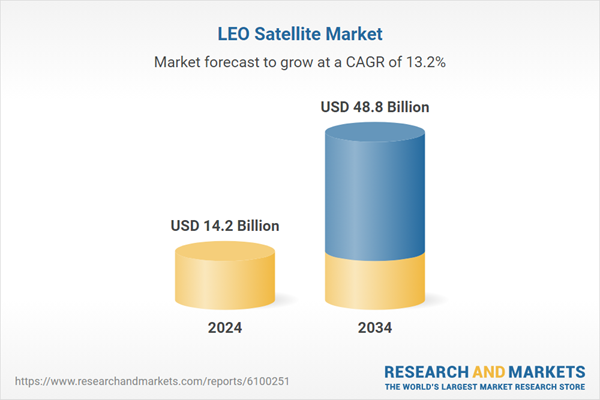The market is witnessing the increasing deployment of small satellites essential components of modern LEO constellations. Their compact size and cost efficiency have significantly lowered entry barriers, enabling applications such as communication, scientific missions, Earth observation, and real-time remote sensing. The shift toward mass production and quicker satellite integration is driven by new commercial policies and innovative aerospace startups, boosting the launch frequency of LEO systems. These small satellites, often deployed in coordinated constellations, help support fast-response missions across military, environmental, and industrial sectors, while enabling a broad array of IoT-driven data solutions worldwide.
The small satellites segment generated USD 6.9 billion in 2023, reflecting its dominant position in the LEO satellite market. These compact satellites are increasingly used for commercial applications, including Earth observation, global telecommunications, scientific experimentation, and technology demonstrations. Their compact size, shorter production cycles, and lower launch costs have allowed them to disrupt traditional space models by enabling more agile, responsive, and cost-efficient missions. Public and private sector players are deploying constellations of these satellites to enhance global coverage, real-time imaging, and rapid data transmission.
The L-Band spectrum, operating in the 1-2 GHz range, accounted for a 11.6% share in 2024. Though limited in bandwidth, L-Band offers highly reliable service for communication across sectors where signal resilience is crucial. Its ability to perform under heavy cloud cover, rain, or other atmospheric disruptions makes it ideal for aviation systems, marine communication, and land-based mobile services. Its consistent signal quality and low latency drive adoption for mission-critical applications in mobility and defense-related satellite communication.
Germany LEO Satellite Market is projected to reach USD 1.5 billion by 2034, driven by the country’s strong commitment to aerospace innovation and satellite-based research. With well-established collaborations with the European Space Agency (ESA), Germany contributes to Earth observation missions, scientific satellite projects, and climate-focused programs. The country's focus on dual-use space assets, combining civilian and defense applications, enhances its role in both public and commercial satellite development.
Top companies leading the Global LEO Satellite Market include Northrop Grumman, Lockheed Martin Corporation, Airbus U.S. Space & Defense, Inc., and SpaceX. These players are securing their foothold by developing high-throughput satellite systems, expanding launch capabilities, and forging strategic partnerships with telecom providers and national agencies. Investments in modular satellite architectures and vertical integration are helping reduce costs and improve turnaround times. Furthermore, companies are adopting reusable launch technologies and AI-driven satellite operations to boost system efficiency and enhance global coverage, ensuring they remain at the forefront of the expanding LEO satellite landscape.
Comprehensive Market Analysis and Forecast
- Industry trends, key growth drivers, challenges, future opportunities, and regulatory landscape
- Competitive landscape with Porter’s Five Forces and PESTEL analysis
- Market size, segmentation, and regional forecasts
- In-depth company profiles, business strategies, financial insights, and SWOT analysis
This product will be delivered within 2-4 business days.
Table of Contents
Companies Mentioned
The companies featured in this LEO Satellite market report include:- AAC Clyde Space
- Airbus U.S. Space & Defense, Inc.
- Apex
- Blue Canyon Technologies
- GomSpace
- Lockheed Martin Corporation
- NanoAvionics
- Nara Space
- Northrop Grumman
- OHB SE
- Planet Labs PBC
- Rocket Lab USA
- SNC
- SpaceX
- Spire Global
- Surrey Satellite Technology Ltd
- SWISSto12
- Thales
Table Information
| Report Attribute | Details |
|---|---|
| No. of Pages | 190 |
| Published | May 2025 |
| Forecast Period | 2024 - 2034 |
| Estimated Market Value ( USD | $ 14.2 Billion |
| Forecasted Market Value ( USD | $ 48.8 Billion |
| Compound Annual Growth Rate | 13.2% |
| Regions Covered | Global |
| No. of Companies Mentioned | 19 |








![LEO Satellite Market by Subsystem [Satellite Bus (Command & Data Handling, Electric Power System), Payload (Optical, Infrared, Radar), Solar Panel, Satellite Antenna], Satellite Mass, Application, End Use, Frequency, and Region - Global Forecast to 2030 - Product Image](http://www.researchandmarkets.com/product_images/12240/12240064_60px_jpg/leo_satellite_market.jpg)
